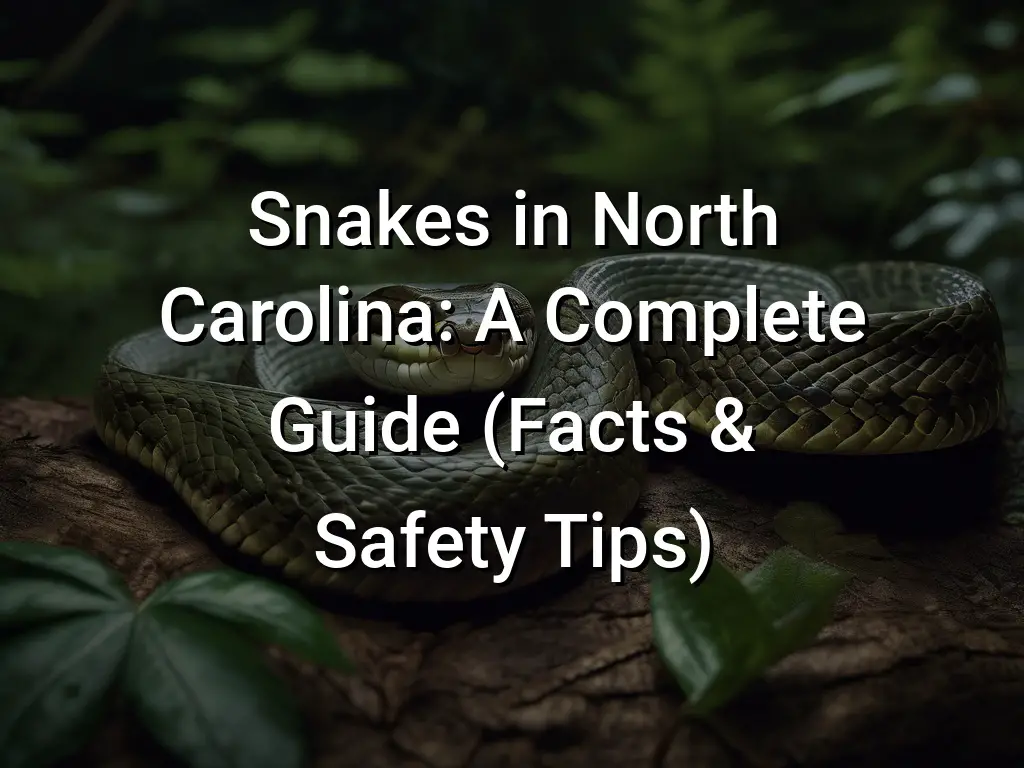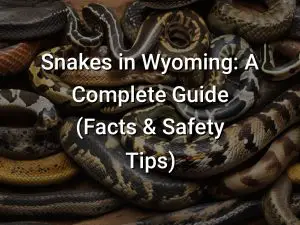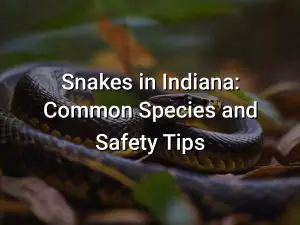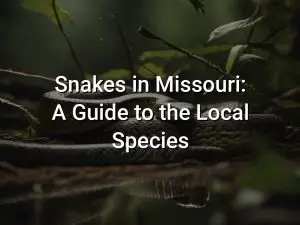Snakes in North Carolina: A Complete Guide (Facts & Safety Tips)

North Carolina, known for its natural beauty and diverse wildlife, is home to a variety of snake species. Whether you’re a nature enthusiast or just curious about the slithering creatures that inhabit this state, this complete guide will provide you with all the fascinating facts and safety tips you need to know about snakes in North Carolina.
From venomous species like rattlesnakes and copperheads to non-venomous ones like black racers and garter snakes, we’ll explore the different types of snakes you might encounter in North Carolina. Learn about their behaviors, habitats, and how to stay safe while enjoying the great outdoors. So, let’s dive in and unravel the secrets of North Carolina’s snake population!
Quick Links
Types of Snakes in North Carolina
North Carolina is home to a diverse array of snake species. Whether you’re an avid herpetologist or just curious about the local wildlife, here are some of the snakes you may encounter in North Carolina:
- Rattlesnakes: North Carolina is home to several species of venomous rattlesnakes, including the Eastern Diamondback, Timber Rattlesnake, and Pigmy Rattlesnake. These snakes have distinct rattles on their tails and should be approached with caution.
- Copperheads: Copperheads are venomous snakes with a distinctive copper-colored head. They are commonly found in wooded areas and are known for their camouflage.
- Cottonmouths: Also known as Water Moccasins, Cottonmouths are venomous snakes that are typically found in or near water sources. They can be identified by their dark coloring and white mouth, which they often display as a warning.
- Eastern Rat Snakes: Eastern Rat Snakes, also known as Black Rat Snakes, are a non-venomous snake species commonly found in North Carolina. They are excellent climbers and are known for their ability to control rodent populations.
- Eastern Kingsnakes: Eastern Kingsnakes are non-venomous snakes that are beneficial to humans as they prey on rodents, including venomous snakes. They have a boldly patterned black and white or black and yellow coloration.
- Black Racers: Black Racers are non-venomous snakes that are incredibly fast and agile. They are black in color and are often found in open grasslands and fields.
- Garter Snakes: Garter Snakes are non-venomous snakes that are commonly found in North Carolina. They have distinct stripes running along their bodies and are often encountered near water sources.
While encountering snakes in North Carolina is not uncommon, it is important to remember that most snakes are non-venomous and play a vital role in the ecosystem. If you come across a snake, it is best to observe it from a safe distance and avoid provoking or attempting to handle it.
Venomous Snakes in North Carolina
North Carolina is home to several venomous snake species, including:
- Rattlesnakes: North Carolina is home to two species of rattlesnakes – the Eastern Diamondback Rattlesnake and the Timber Rattlesnake. These snakes are easily recognizable by their distinctive rattles on the end of their tails.
- Copperheads: Copperheads are another venomous snake species found in North Carolina. They have distinctive copper-colored heads, hence the name.
- Cottonmouths: Also known as Water Moccasins, Cottonmouths are venomous semi-aquatic snakes found in North Carolina’s wetland areas.
It’s important to exercise caution and be aware of these venomous snakes when exploring outdoor areas in North Carolina. If you encounter a venomous snake, it’s best to keep your distance and avoid provoking or handling them.
Remember, snakes play an important role in the ecosystem and should be respected and admired from a safe distance.
Non-Venomous Snakes in North Carolina
North Carolina is home to a variety of non-venomous snakes that play important roles in the ecosystem. These snakes are harmless to humans and can even be beneficial by controlling rodent populations.
One common non-venomous snake in North Carolina is the Eastern Rat Snake. These snakes are large, with adults reaching lengths of 5 to 7 feet. They are excellent climbers and can often be found in trees or other elevated areas. Eastern Rat Snakes are constrictors, meaning they suffocate their prey by coiling around them.
Another non-venomous snake that can be found in North Carolina is the Eastern Kingsnake. These snakes are known for their striking black and yellowish-white bands. They are skilled hunters that primarily feed on other snakes, including venomous species like copperheads and rattlesnakes.
Black Racers are also non-venomous snakes commonly found in North Carolina. They are known for their incredible speed and agility. Black Racers can reach speeds of up to 10 miles per hour and are excellent climbers. They primarily feed on small mammals, birds, and lizards.
Garter Snakes are smaller non-venomous snakes that can be found throughout North Carolina. They are known for their distinctive striped patterns, which can vary in color. Garter Snakes are often found near water sources, as they are excellent swimmers. They primarily feed on small fish, frogs, and insects.
It’s important to remember that even though these snakes are non-venomous, it’s always best to appreciate them from a distance and not to handle them unless you are a trained professional. Snakes, even non-venomous ones, may still bite if they feel threatened.
Rattlesnakes in North Carolina
Rattlesnakes are one of the venomous snake species that can be found in North Carolina. They are known for the distinctive rattle at the end of their tails, which acts as a warning signal when they feel threatened. North Carolina is home to two species of rattlesnakes: the Eastern Diamondback Rattlesnake and the Timber Rattlesnake.
The Eastern Diamondback Rattlesnake is the largest venomous snake in North America and can reach lengths of up to 8 feet. It has a series of diamond-shaped markings along its back and a large, thick body. Despite its intimidating appearance, the Eastern Diamondback Rattlesnake is generally non-aggressive and will only bite as a last resort if it feels threatened.
The Timber Rattlesnake is slightly smaller than the Eastern Diamondback, reaching lengths of up to 5 feet. It has a grey or yellow-brown body with dark, V-shaped markings along its back. Like other rattlesnakes, the Timber Rattlesnake is also typically non-aggressive, but it will defend itself if provoked.
Encounters with rattlesnakes in North Carolina are relatively rare, but it’s important to be cautious when exploring their habitats. If you do come across a rattlesnake, give it a wide berth and do not attempt to handle or provoke it. Rattlesnake bites can be dangerous and require immediate medical attention.
Remember, snakes play an important role in the ecosystem and should be respected from a safe distance. By understanding the types of snakes in North Carolina and following safety guidelines, you can coexist with these fascinating creatures in their natural habitat.
Copperheads in North Carolina
Copperheads are a type of venomous snake that can be found in North Carolina. They are known for their distinctive copper-colored heads, which give them their name. Copperheads are medium-sized snakes that can grow to be around 2-3 feet long.
These snakes are typically found in wooded areas, forests, and rocky hillsides. They prefer to live in areas with dense vegetation and hiding spots, such as fallen logs or piles of leaves. Copperheads are more active during the warmer months, and they can often be found sunning themselves on rocks or tree branches.
One of the key features of copperheads is their venomous bite. While copperhead bites are rarely fatal, they can be extremely painful and cause swelling, bruising, and tissue damage. It is important to exercise caution and avoid approaching or provoking copperheads if you encounter them in the wild.
If you do come across a copperhead, it is best to give it a wide berth and allow it to move away on its own. Copperheads are generally non-aggressive and will only bite if they feel threatened or cornered. If you are bitten by a copperhead, seek medical attention immediately.
It is important to note that copperheads, like all snakes, play a vital role in the ecosystem as predators of rodents and other small animals. It is best to appreciate them from a distance and respect their habitats.
To stay safe while hiking or spending time outdoors in North Carolina, make sure to wear appropriate footwear and clothing, stay on designated trails, and be aware of your surroundings. Educate yourself on the different species of snakes that inhabit the area and familiarize yourself with their distinctive features to help identify them.
By being informed and taking necessary precautions, you can enjoy the beauty of North Carolina’s wildlife while staying safe from any potential encounters with copperheads or other snakes.
Cottonmouths in North Carolina
Cottonmouths, also known as water moccasins, are venomous snakes that can be found in North Carolina. They are semi-aquatic and are commonly found near bodies of water such as swamps, rivers, and lakes.
These snakes are known for their distinctive appearance, with a dark-colored body and a wide, white or pale yellow mouth that gives them their name. They can grow to be around 4 to 5 feet long.
As venomous snakes, cottonmouths have venom that they use to immobilize their prey. If bitten by a cottonmouth, it is important to seek medical attention immediately. Symptoms of a cottonmouth bite may include severe pain, swelling, and tissue damage.
It is important to be cautious when encountering a cottonmouth in the wild. These snakes are generally not aggressive, but they may become defensive if they feel threatened. It is best to keep a safe distance and avoid provoking or handling them.
If you encounter a cottonmouth in your yard or near your home, it is recommended to contact a professional snake removal service to ensure safe removal and relocation of the snake.
- Avoid walking barefoot in areas where cottonmouths may be present, especially near bodies of water.
- When hiking or exploring outdoors, stick to well-worn paths and be mindful of your surroundings.
- If you come across a cottonmouth, give it plenty of space and do not attempt to handle or provoke it.
- Teach children about the dangers of snakes and how to identify and avoid them.
- Keep your yard well-maintained and free of debris to reduce potential snake habitats.
- If you suspect a cottonmouth is on your property, contact a professional snake removal service for assistance.
By being aware of the presence of cottonmouths in North Carolina and taking necessary precautions, you can safely coexist with these snakes in their natural habitat.
Eastern Rat Snakes in North Carolina
Eastern Rat Snakes, also known as Black Rat Snakes, are one of the most common and largest snakes found in North Carolina. They are non-venomous and play an important role in controlling rodent populations, which is why they are often regarded as beneficial to have around.
These snakes are typically dark brown or black in color with a white or yellow underside. They have a slender body and can grow up to 6 to 7 feet in length, although some individuals have been known to reach lengths of 8 feet or more.
Eastern Rat Snakes are excellent climbers and are often found in trees, where they search for bird nests and small mammals to feed on. They are known to be active during the day and can often be spotted basking in the sun on rocks or tree branches.
When threatened, Eastern Rat Snakes may vibrate their tails and release a foul-smelling musk as a defense mechanism. However, they are generally non-aggressive and will usually try to flee when encountered by humans.
It’s important to remember that although Eastern Rat Snakes are non-venomous, they can still bite if they feel threatened or cornered. If you come across an Eastern Rat Snake in North Carolina, it’s best to observe it from a safe distance and avoid trying to handle or provoke it.
If you have a rat or mouse problem in your home or property, having an Eastern Rat Snake around can be beneficial in naturally controlling their populations. However, if you wish to remove a snake from your property, it’s best to contact a professional wildlife removal service to ensure it is done safely and humanely.
Overall, Eastern Rat Snakes are fascinating reptiles that play an important role in North Carolina’s ecosystem. By understanding their behavior and characteristics, you can coexist with them safely and appreciate their role in nature.
Eastern Kingsnakes in North Carolina
Eastern Kingsnakes, also known as the Lampropeltis getula, are non-venomous snakes that are commonly found in North Carolina. They are known for their distinctive black coloration with yellow or white bands that run across their bodies.
These kingsnakes are excellent climbers and can be found in a variety of habitats including forests, fields, and wetlands. They are particularly skilled at hunting other snakes, including venomous species, making them a valuable natural predator.
Eastern Kingsnakes are constrictors, which means they capture their prey by coiling their bodies around them and squeezing until the prey cannot breathe. They primarily feed on small mammals, birds, lizards, and other snakes.
If you encounter an Eastern Kingsnake in North Carolina, there is no need to be alarmed. They are non-venomous and pose no threat to humans. In fact, they can be beneficial to have around as they help control populations of venomous snakes such as copperheads and rattlesnakes.
It is important to admire Eastern Kingsnakes from a distance and avoid handling them. Like all wildlife, they should be left undisturbed in their natural habitat. If you spot an Eastern Kingsnake in your yard or property, it is best to let it go about its business and continue its important role in maintaining the ecosystem.
Black Racers in North Carolina
The Black Racer is a non-venomous snake species that can be found in North Carolina. These snakes are known for their sleek, black appearance and their active and fast movements. They are commonly found in a variety of habitats, including forests, fields, and even suburban areas.
Black Racers are excellent climbers and swimmers, and they are also known for their speed, agility, and alertness. They are active during the day and are often seen basking in the sun to regulate their body temperature.
These snakes primarily feed on small animals such as rodents, birds, frogs, and lizards. They are constrictors, meaning they wrap their bodies around their prey to suffocate them before swallowing them whole.
When threatened, Black Racers will typically flee rather than fight. They may vibrate their tail as a defense mechanism, but they are not known to be aggressive towards humans.
If you encounter a Black Racer in North Carolina, it is best to observe it from a safe distance and avoid trying to handle or capture it. These snakes play an important role in the ecosystem by controlling populations of small animals, and it is best to leave them undisturbed in their natural habitat.
Garter Snakes in North Carolina
Garter snakes are non-venomous snakes commonly found in North Carolina. They are known for their long, slender bodies and vibrant colors, with a distinct pattern of stripes running down their backs.
In North Carolina, the most common species of garter snake is the Eastern Garter Snake (Thamnophis sirtalis sirtalis). These snakes can be found in a variety of habitats, including forests, wetlands, and open grassy areas.
Garter snakes are typically harmless to humans and play an important role in controlling rodent populations. They primarily feed on small mammals, insects, frogs, and other small prey.
These snakes are active during the day and are often seen sunning themselves on rocks or logs. Garter snakes are also known for their ability to release a foul-smelling musk when threatened, which serves as a defense mechanism.
If you encounter a garter snake in North Carolina, it is best to observe it from a distance and avoid any attempts to handle or harm the snake. Garter snakes are protected wildlife in North Carolina, and it is illegal to kill or capture them without a permit.
Remember, snakes play an important role in our ecosystems and should be respected and appreciated for their contributions to the natural world.
Conclusion
Snakes are a common sight in North Carolina, with both venomous and non-venomous species inhabiting the region. It’s important for residents and visitors to be aware of the types of snakes present and to take necessary precautions to ensure their safety.
By familiarizing yourself with the various snakes in North Carolina and understanding their behaviors, you can better enjoy the outdoors while minimizing the risk of snake encounters. Remember to stay alert, keep a safe distance from snakes, and seek professional assistance if you encounter a venomous snake. With proper knowledge and caution, you can coexist with the diverse snake population in North Carolina.






